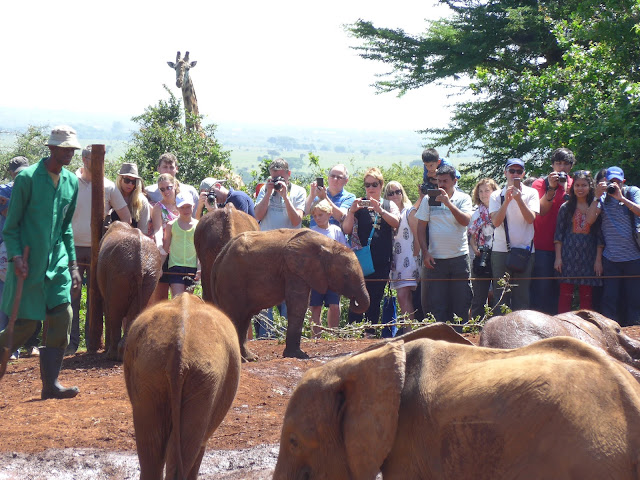We are blessed to have family visit here over the Christmas and New Year's holidays - Ken and Martha June, Cristina's parents (here standing in front of our rental Naishi guest house at Lake Nakuru Natl Park). We took a 6 day trip around to some parks northwest of Nairobi.
As is usually the case for posting blogs about our trips, Evan has enthusiastically helped with getting these pictures and captions up! And also as usual, you can look at the "
more pictures" page if you want to see more pictures from this trip. The "
birds of Kenya" page is also updated with bird pictures from this trip.
 |
| Bored looking zebra |
 |
| Rothschild's giraffe. This is a highly endangered subspecies, with only a few hundred individuals left. They were reintroduced into Lake Nakuru Natl Park, and we saw a good number of them |
 |
| Lake Nakuru, one of a string of gorgeous rift valley lakes in Kenya. |
 |
| Sleepy, lazy lions. As we were leaving in the morning, the warden said he just heard there was a pride of lions a short bit down the road from our guest house. Sure enough, they were hanging out on the road. They meandered off shortly after we arrived, and quickly became invisible in the grass. |
 |
| Honey at Lake Bogoria. Around Bogoria and Baringo honey and fish are the staple foods that are harvested, as it's too arid to do any substantial farming. We saw lots of people selling the acacia honey, and indeed it was delicious. |
 |
| A flamboyant of flamingos (mostly greater) at Lake Bogoria. Bogoria is known for having millions of flamingos. Most are in Tanzanzia at the moment nesting, but there were several thousands in small flocks ("flamboyants") along the edge of the lake. This group was on our side, so we were were able to sneak up on them. We saw lots of great birds on the trip, see the updated "birds of Kenya" post for more bird pictures from this trip. |
 |
| Hot springs at Lake Bogoria, Being in the rift valley, there are lots of interesting geothermal formations in the area. Here there are some bubbling hot springs along the edge of the lake that we enjoyed exploring. |
 |
| Lake Baringo is a birding hotspot in Kenya, with many hundreds of bird species present. Alex and Evan were enthusiastic birders! |
 |
| Lake Baringo at night. We enjoyed the night sky on this trip, a nearly full moon and looking at the constellations. This is a night exposure, so it was actually dark out, but the camera shutter was held open long enough to make it look light. |
 |
| A bloat of hippopotami at Lake Baringo. There are several hundred in the lake, and we saw them often, or heard their loud noises. They wander up on the camp grass shoreline to graze at night, so we stayed near the cottage when it was dark. |
Fish eagle at Baringo. Here the video shows one swooping down to pick up a fish, our guide on a boat ride called the eagle in for this show!
 |
| Sleepy nile croc at Lake Baringo. We saw lots of these, on the shoreline outside our cottage. At this lake, they are not aggressive, so we didn't have to worry too much about them, but enjoyed seeing them. |
 |
| Hornbill looking for food at Lake Baringo. There was tremendous wildlife to watch here, often coming up close to inspect us! This is a Jackson's hornbill examining our pancakes at breakfast. |
 |
| Jackson's hornbill |
 |
| Common ostriches at Lake Baringo. "Louis Baringo" was our guide, he was an amazing birder who pointed out lots of great species for us. Here we took a late afternoon hike to a basalt escarpment. Along the way we ran into ostriches, here are a couple of females. Like so many Kenyans, Louis was unfazed by walking long distances in the arid heat without water while we wazungu were lagging a bit from the intense sun! The boys rapidly regained energy when he took us climbing up a trail in the cliffs shown in the background. |
 |
| View climbing out of the Kerio valley towards Iten, with gorgeous waterfalls, and paragliders drifting overhead. At the top of the climb, the road passes through Iten, which sits on the edge of the cliff and is the home of the champion Kenyan runners from the Kalenjin group. |
 |
| Tree at Kakamega torest. Our next stop was this forest reserve towards the Uganda border, which is a remnant of the larger Congo-Guinea rain forest that stretches across central Africa. This is the only remaining piece of that forest in Kenya, so contains some wildlife not found in any other place in the country. Alex especially enjoyed being back in the forest, it reminded him of the diversity found in his beloved Appalachian forests! |
 |
| View at Kakamega forest. We found a viewpoint that had a spectacular view over the forest, where we could sit and watch hornbills flying across the rainforest, and several species of monkeys crashing through the canopy of the trees below. |
 |
| Trees and people. Alex and Cristina walking near our guest house in the rainforest. |
 |
| Watering trees in Eldoret. Our last stop was to visit friends from our church in Harrisonburg, who live in Eldoret. We helped them water some podocarp trees they had planted along a road near their house. Their sons Daniel and Jacob and Daniel are Alex and Evan's age, so all the boys enjoyed being together again. |
 |
| It was great to have a gathering of "CMC Africa" |























































